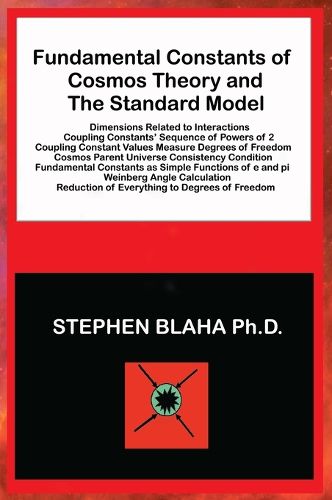Readings Newsletter
Become a Readings Member to make your shopping experience even easier.
Sign in or sign up for free!
You’re not far away from qualifying for FREE standard shipping within Australia
You’ve qualified for FREE standard shipping within Australia
The cart is loading…






The growing interest in Cosmos Theory, and some major new significant results, have motivated this new book. It covers a host of topics beginning with a more detailed derivation of the Consistency Condition for the origin of the Cosmos that was presented in earlier books.
From there it proceeds to describe new results that stem, in part, from the consideration of the Consistency Condition. The consequence of the book: There is a unifying principle based on degrees of freedom, which is at the basis of Cosmos Theory and is found in its spaces, symmetries, universes, universe structure, energies, and particle interactions.
The book covers numerous topics including:
The r = 18 space is shown to be the first even dimension integer (most minimal) space whose universe does not collapse. Thus it is an optimal choice for the parent Cosmos space for an r = 18 universe. Within that universe sub-universes may be created that may undergo Hubble expansion. It is possible that there are many such unrelated parent universes with their own sub-universes.
Due to the factor (2epi/r)r the dimension r =17.08 marks the critical dimension for the transition from a contracting universe.
The consistency condition embodies a factor epi/4 = 2.13 where e = 2.718 is the natural logarithm base constant. It appears in the factor (2epi/r)r ? (17.08/r)r where r is the dimension. Dimension thus has a numerical origin.
This author proposes a new constant of Nature cg, which appears in many contexts in Astrophysics and Elementary Particle Physics. cg = pi squared / 128. The relation between temperature and mass of an entity is given by kT = mcg.
The book shows a variety of fundamental constants may be expressed in terms of simple consistent expressions using the natural logarithm base e and pi = 3.14159.
Coupling constants values for ElectroWeak and Strong coupling constants are shown to exhibit a sequence in powers of 2 just like Cosmos Theory dimension arrays.
The Weinberg angle.is calculated to within 8%.
Coupling constants are shown to be equivalent to products of factors wherein each factor represents degrees of freedom.
Everything is a manifestation of degrees of freedom: dimensions, internal symmetry coupling constants, dimension arrays, universes, and spaces.
$9.00 standard shipping within Australia
FREE standard shipping within Australia for orders over $100.00
Express & International shipping calculated at checkout
The growing interest in Cosmos Theory, and some major new significant results, have motivated this new book. It covers a host of topics beginning with a more detailed derivation of the Consistency Condition for the origin of the Cosmos that was presented in earlier books.
From there it proceeds to describe new results that stem, in part, from the consideration of the Consistency Condition. The consequence of the book: There is a unifying principle based on degrees of freedom, which is at the basis of Cosmos Theory and is found in its spaces, symmetries, universes, universe structure, energies, and particle interactions.
The book covers numerous topics including:
The r = 18 space is shown to be the first even dimension integer (most minimal) space whose universe does not collapse. Thus it is an optimal choice for the parent Cosmos space for an r = 18 universe. Within that universe sub-universes may be created that may undergo Hubble expansion. It is possible that there are many such unrelated parent universes with their own sub-universes.
Due to the factor (2epi/r)r the dimension r =17.08 marks the critical dimension for the transition from a contracting universe.
The consistency condition embodies a factor epi/4 = 2.13 where e = 2.718 is the natural logarithm base constant. It appears in the factor (2epi/r)r ? (17.08/r)r where r is the dimension. Dimension thus has a numerical origin.
This author proposes a new constant of Nature cg, which appears in many contexts in Astrophysics and Elementary Particle Physics. cg = pi squared / 128. The relation between temperature and mass of an entity is given by kT = mcg.
The book shows a variety of fundamental constants may be expressed in terms of simple consistent expressions using the natural logarithm base e and pi = 3.14159.
Coupling constants values for ElectroWeak and Strong coupling constants are shown to exhibit a sequence in powers of 2 just like Cosmos Theory dimension arrays.
The Weinberg angle.is calculated to within 8%.
Coupling constants are shown to be equivalent to products of factors wherein each factor represents degrees of freedom.
Everything is a manifestation of degrees of freedom: dimensions, internal symmetry coupling constants, dimension arrays, universes, and spaces.